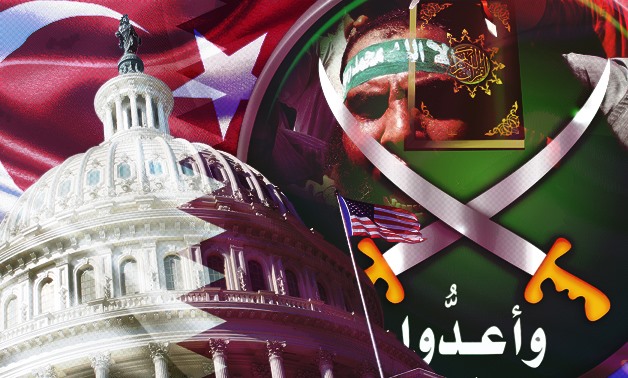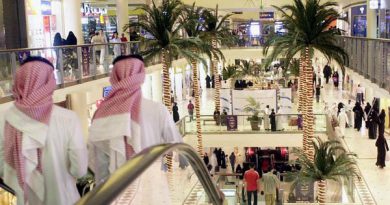“Blood Money”: Analyzing Qatar’s dirty operation to influence United States
by Huntsman
“Blood Money” is a punchy and lucid overview of a dirty, hidden aspect of the geopolitical game.
A key weakness of the US’ Middle East stance is its dependence on the location and cooperation of unreliable allies. The region, riven by conflict for millennia, has further been destabilized for years now by one of these US allies – Qatar.
Recently, I circled back to “Blood Money”, Cernovich‘s fantastic short-form documentary on the influence operation being carried out by Qatar in the United States.
Jutting out from the coast of eastern Saudi Arabia into the Persian Gulf, Qatar is a small Middle Eastern nation with an outsized influence. The population is about 2.8 million, but notably, only a little more than 300,000 are actual Qataris. The rest are foreign residents.

From 2000 to 2019, the population has grown more than 387%. All of that growth is from foreigners brought in under the “kafala” migrant system. Qatar is largely a modern nation built on slave labor. The 88% of the population that are non-Qatari are treated differently.
This matters, because Qatar is awash in oil and natgas revenues. The massive underclass suffers. Not so for the native Qataris. With only 300,000 or so Qataris participating in the economy at a high earning level, Qatar has the highest adjusted GDP/capita in the world.

Qatar holds the third-largest known reserves of natural gas, and as of mid-2019, is jockeying with Australia for being the leading natgas exporter in the world. Qatar’s oil and natgas revenues comprise about 60% of its annual Gross Domestic Product (GDP) – $191B.
Given its minor military budget ($1.91B, or 1% of GDP), Qatar has obviously chosen a different force multiplier for maintaining its relevance. By comparison, China spends 1.9% of its GDP on its military budget. The US is at 3.2%. Qatar’s rival, Saudia Arabia, is at 8.8%.
As can be seen, Qatar does not spend its wealth on an equitable standard of living for all of its subjects. Nor does it secure its agenda through military might. What it does do very, very well is public relations and sponsorship of specific radical Islamic factions.
Qatar is home to the prominent pan-Arab media outlet, Al Jazeera. AJ is partially state-funded by the massive sovereign wealth of Qatar, and carries out aggressive reporting against Israel, KSA, and other Qatari rivals. It will never be critical of the ruling Al-Thanis.
As highlighted throughout “Blood Money” by David Reaboi (especially at 6:20 into the film), the major effort of Qatar’s media efforts is to promote and sustain a radically anti-Western agenda. This great piece by Mr Reaboi provides additional color.
Further, “Blood Money” highlights a second concurrent type of influence operation being carried out by Qatar in the US. Jack Posobiec‘s segment beginning at 2:45 shines a light on a practice little-known by the average American – lobbying specifically for a foreign nation.
Additionally, as J Michael Walker notes at 16:55, major “think tanks” such as @Brookings Institute often receive financial support, in exchange for their efforts to shape policy on specific issues. The dollars are staggering, with $24 million just to Brookings alone.
“Blood Money” is a punchy and lucid overview of a dirty, hidden aspect of the geopolitical game. Cernovich, his production team, David Reaboi, Jack Posobiec, and others perfectly perform the urgent and vital job of highlighting mechanisms of foreign influence operations.
Understand though, “Blood Money” is a jumping-off point. It leaves the viewer begging the question of “why”. Why would Qatar go to such great lengths and expense to influence US policy and public narrative? The answer is complex, but then, the world is rarely simple.
Critical to understanding what follows is for the reader to check their moral biases at the door. The world is often an ugly contest where bare-knuckle power is the only prize that matters. Everything is a weapon, especially where it concerns the cradle of civilization.
By and large, Qatar’s concern to the United States is not its energy production, but its position as an ally that hosts the largest US airbase in the region – Al Udeid Air Base. With more than 11,000 US personnel reportedly stationed there, AUAB is a vital asset.

As with the influence operations highlighted in “Blood Money”, Qatar’s efforts to cozy up to Washington via defense partnerships and materiel purchases is an attempt to keep US support as the rest of the Gulf Cooperation Council (GCC) maintains its embargo on Qatar.
The significance of AUAB cannot be overstated. It hosts the 379th Expeditionary Wing, which is comprised of more than 100 aircraft, including strategic bombers, cargo planes, refuelers, and surveillance/battle management platforms. AUAB also hosts F-22 Raptors.
UAB is a significant part of the US’ posture in the region. Combined with an estimated 15,000 US personnel in Kuwait and another 7,000 at NSA Bahrain, the 11,000 personnel at AUAB represent a large force. The US will overlook a lot to protect that asset.

Qatar relies on the US looking the other way. Aside from its aforementioned terrible treatment of foreign-born labor, Qatar is also one of the primary destabilizing influences in the region. Let’s return to “Blood Money” for a moment, and the brilliant David Reaboi.
Beginning at 6:20, Reaboi outlines how Al Jazeera, the aforementioned state-funded media arm of Qatar, propagandized for the “Arab Spring”. The net effect – in fact, the likely goal – of Qatar’s efforts was to topple US-friendly regimes and install the Muslim Brotherhood.
The Muslim Brotherhood (“MB”), founded in 1928 by Egyptian Imam Hassan al-Banna, is a powerful fundamentalist theocratic Sunni Islamic group. Due to its alleged ties to terrorist groups, several GCC nations have designated the MB as terrorists themselves.
In mid-2017, the issue came to a boil when Egypt, Saudia Arabia, Bahrain, and United Arab Emirates sanctioned Qatar for its alleged significant financial support of the MB in the Middle East and around the world. The embargo, still ongoing, has fractured the Middle East.
It also had two notable knock-on effects, besides putting the US in the middle of two critical (but problematic) allies in Saudi Arabia and Qatar.
First, it exposed Qatar’s quiet connections to Iran. Second, it brought Turkey and Qatar into open alignment.
Despite seemingly-major geopolitical and ideological differences, Qatar has quietly nurtured a connection to the cash-poor regime in Tehran. Due to separate sanctions and embargoes, as well as their position inside the Persian Gulf, Iran and Qatar need one another.
Further, they are irrevocably tethered by their shared access to the South Pars/North Field natgas field offshore of Qatar. This is the same natgas field that fuels Qatar’s world-leading per-capita GDP. Iran’s piece of the revenue is estimated at $5b+/yr.
Logistically, Qatar is in the driver’s seat. Their state-owned liquefied natgas shipping company, Nakilat, controls the world’s largest fleet of LNG-carrying ships at 65+ vessels. Additionally, Nakilat has budgeted $12B for 60+ more vessels to be built in South Korea.
Nakilat has enabled Qatar to survive and even thrive during the 2.5-year embargo imposed by the GCC. Iran, comparatively, has a large crude oil tanker fleet, but due to sanctions has had to resort to all manner of illicit smuggling to get Iranian oil to the world markets.
It is in the pragmatic interest of Qatar for Iran to remain somewhat stable. In the event of a shooting war in the region, air and naval power would be rapidly brought to bear. This means air missions out of AUAB, and a possible blockade of the crowded Strait of Hormuz.
A maritime blockade would prevent Qatari natgas from reaching global markets, and trigger buyer demand to shift to Malaysia, Nigeria, Australia, Indonesia, and the US. It would also further bleed Qatar’s foreign exchange reserves, currently only 50th in the world.
And beyond the practical logistics, energy, and financial issues, Qatar also sees merit in Iran’s vast network of political and paramilitary proxies around the world. Despite the Shia/Sunni divide, Iran and Qatar both view Saudi Arabia and Israel with malice.
This “enemy of my enemy is my friend” stance is denied vehemently by both Qatar and Iran. However, as Irina Tsukerman highlights in her very recent, exceptional article on Small Wars, there’s a dark bent to the Qatar/Iran relationship. Bookmark it.
When viewed through the all-encompassing theocratic lens of the Muslim Brotherhood, Qatar’s relationship with Iran makes great strategic sense. This same reasoning extends to Qatar’s tacit support of the Taliban in Afghanistan, and overt support of Hamas in Palestine/Israel.
As mentioned above, Qatar is also antagonistic to US-backed governments in the region, including support for the MB’s short-lived reign atop Egypt. And the prominent American think tank Brookings Institute argued for the MB.
Having established Qatar’s deep ties to Iran and the Brotherhood, we must also highlight another critical alliance for Qatar: Turkey. As I noted previously, Turkish president Erdogan aims to reestablish the global Islamic caliphate.
Here again, it is geopolitical realpolitik and ideological kinship that drives the Qatar/Turkey partnership. In fact, the relationship is so staunch that Qatar refuses to reduce its ties to Turkey in exchange for the lifting of the 2017 GCC embargo.
Turkey has played a significant partner role to Qatar: – Assistance in mitigating the impact of the 2017 embargo – Support for the MB’s activities in Syria, Egypt, and elsewhere – Construction of a new Turkish military base in Qatar plus 5,000 troop commitment.
And as with the US’ own base in Incirlik, which Turkey has leveraged many times to manipulate the US, the new Turkish-Qatari base will likely play out similarly as a counterbalance to AUAB and US interests. Qatar has also committed to purchasing 100 Turkish-made tanks.
From an ideological standpoint, both Turkey and Qatar are indeed avid supporters for the MB. However, their common alignment against Saudi Arabia and Israel is the tie that binds. Qatar’s antipathy to both is well-established. However, Turkey is just as hostile.
As “exclusively” reported in the Middle East Eye – a London-based media outlet founded by former Al Jazeera bigwigs – the Saudis are accused of crafting a strategic plan to “take Turkey down”. Let’s dig into MEE and anti-Saudi news quickly.
The MEE allegedly has strong ties to various MB proxies, and has been blocked in KSA and United Arab Emirates for MEE’s very pro-Qatar/Turkey editorial bent. Notably, Jamal Kashoggi, the infamously-murdered Saudi national, wrote for the MEE before joining the WaPo’s staff.
The Kashoggi murder in late 2018 is an ordeal worth its own thread, and has been extensively covered in many places by better minds. The upshot is that it tilted Turkey firmly against KSA, and set the US at odds with KSA as well. Qatar and Turkey both benefitted from this.
Returning once again to the titular “Blood Money”, we see that Qatar runs an extremely advanced media and human-capital influence operation that spans the US, Europe, and MENA region. Not just Al Jazeera, but also MEE, numerous think-tanks, NGO’s, and major universities.
The deeply-intertwined Muslim Brotherhood/Turkey/Iran/Qatar nexus stands in stark opposition to the US-backed regional coalitions and alliances. And in perhaps nowhere else in the world do we see the convergence of hard, soft, and narrative power.
This is the age of durable disorder. Though this thread has focused extensively on Qatar and, to a lesser extent Iran and Turkey, we cannot forget that Russia and China are heavily involved in the region as well – almost completely against the US.
So what does this mean for the US, and the Gulf region, moving forward? First, so long as Qatar is able to derive massive revenues from the explosive growth in the natural gas sector, it will continue to have ready access to funding streams for terrorism and influence ops.
Second, the US must diligently safeguard itself against hyper-advanced 4th generation warfare (4GW) narrative-building efforts by allies and enemies alike. Third, the US is exposed immensely by its vested, complicated interests in the region.
Without the need for AUAB due to operations in the entire Persian Gulf region (including Afghanistan), the US would not be tied at the hip to Qatar. Lastly, the US is a growing exporter of liquefied natural gas. This strategic resource is an overlooked geopolitical tool.
The largest buyers of natgas are all Asian nations, especially South Korea, Japan, and China. India’s demand is also growing. Undermining Qatari dominance in LNG must be a prime US focus. This means huge investment, including US-flagged LNG shipping vessels a la Nakilat.
There is no excuse for the US not to make these moves. It starves the beast of Qatari influence operations, boxes in Turkey in the Gulf, reduces US exposure in the region, and shores up relationships with key Asian allies. Or, we can simply watch as Qatar runs wild.
Credit again to: Cernovich, David Reaboi, Jack Posobiec, J Michael Waller Irina Tsukerman, Small Wars for their resolute commitment to independent journalism, US national interest, and shining a bright light into the darkest corners of our geopolitical world.
Featured Image credit: Egypt Today.
Huntsman is a pen name for the author of this article. He tweets under @man_integrated.



